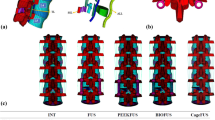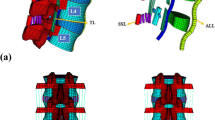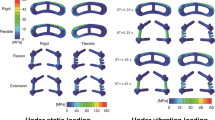Abstract
Purpose
Biomechanical comparison between rigid and non-rigid posterior stabilization systems following lumbar interbody fusion has been conducted in several studies. However, most of these previous studies mainly focused on investigating biomechanics of adjacent spinal segments or spine stability. The objective of the present study was to compare biomechanical responses of the fusion devices when using different posterior instrumentations.
Methods
Finite-element model of the intact human lumbar spine (L1–sacrum) was modified to simulate implantation of the fusion cage at L4–L5 level supplemented with different posterior stabilization systems including (i) pedicle screw-based fixation using rigid connecting rods (titanium rods), (ii) pedicle screw-based fixation using flexible connecting rods (PEEK rods) and (iii) dynamic interspinous spacer (DIAM). Stress responses were compared among these various models under bending moments.
Results
The highest and lowest stresses in endplate, fusion cage and bone graft were found at the fused L4–L5 level with DIAM and titanium rod stabilization systems, respectively. When using PEEK rod for the pedicle screw fixation, peak stress in the pedicle screw was lower but the ratio of peak stress in the rods to yield stress of the rod material was higher than using titanium rod.
Conclusions
Compared with conventional rigid posterior stabilization system, the use of non-rigid stabilization system (i.e., the PEEK rod system and DIAM system) following lumbar interbody fusion might increase the risks of cage subsidence and cage damage, but promote bony fusion due to higher stress in the bone graft. For the pedicle screw-based rod stabilization system, using PEEK rod might reduce the risk of screw breakage but increased breakage risk of the rod itself.





Similar content being viewed by others
References
Carragee EJ, Hurwitz EL, Weiner BK (2011) A critical review of recombinant human bone morphogenetic protein-2 trials in spinal surgery: emerging safety concerns and lessons learned. Spine J 11(6):471–491
Tartara F, Bongetta D, Pilloni G, Colombo EV, Giombelli E (2020) Custom-made trabecular titanium implants for the treatment of lumbar degenerative discopathy via ALIF/XLIF techniques: rationale for use and preliminary results. Eur Spine J 44(3):551–559
Chan AY, Lien BV, Choi EH et al (2020) Back pain outcomes after minimally invasive anterior lumbar interbody fusion: a systematic review. Neurosurg Focus 49(3):E3
Deyo RA, Nachemson A, Mirza SK (2004) Spinal-fusion surgery-the case for restraint. N Engl J Med 350(7):722–726
Fan W, Guo LX (2019) A comparison of the influence of three different lumbar interbody fusion approaches on stress in the pedicle screw fixation system: finite element static and vibration analyses. Int J Numer Method Biomed Eng 35(3):e3162
La Barbera L, Wilke HJ, Liebsch C et al (2020) Impact of lordotic cages in the restoration of spinopelvic parameters after dorsal lumbar interbody fusion: a retrospective case control study. Eur Spine J 29(1):36–44
Mobbs RJ, Phan K, Malham G, Seex K, Rao PJ (2015) Lumbar interbody fusion: techniques, indications and comparison of interbody fusion options including PLIF, TLIF, MI-TLIF, OLIF/ATP. LLIF ALIF J Spine Surg 1(1):2–18
Ahn YH, Chen WM, Lee KY, Park KW, Lee SJ (2008) Comparison of the load-Sharing characteristics between pedicle-based dynamic and rigid rod devices. Biomed Mater 3(4):044101
Park P, Garton HJ, Gala VC, Hoff JT, McGillicuddy JE (2004) Adjacent segment disease after lumbar or lumbosacral fusion: review of the literature. Spine 29(17):1938–1944
Li C, Liu L, Sh JY, Yan KZ, Shen WZ, Yang ZR (2018) Clinical and biomechanical researches of polyetheretherketone (PEEK) rods for semi-rigid lumbar fusion: a systematic review. Neurosurg Rev 41(2):375–389
Kim YS, Zhang HY, Moon BJ et al (2007) Nitinol spring rod dynamic stabilization system and Nitinol memory loops in surgical treatment for lumbar disc disorders: short-term follow up. Neurosurg Focus 22(1):E10
Yuan W, Su QJ, Liu T et al (2017) Evaluation of Coflex interspinous stabilization following decompression compared with decompression and posterior lumbar interbody fusion for the treatment of lumbar degenerative disease: a minimum 5-year follow-up study. J Clin Neurosci 35:24–29
Kuo CH, Huang WC, Wu JC et al (2018) Radiological adjacent-segment degeneration in L4–5 spondylolisthesis: comparison between dynamic stabilization and minimally invasive transforaminal lumbar interbody fusion. J Neurosurg Spine 29(3):250–258
Ponnappan RK, Serhan H, Zarda B, Patel R, Albert T, Vaccaro AR (2009) Biomechanical evaluation and comparison of polyetheretherketone rod system to traditional titanium rod fixation. Spine J 9(3):263–267
Chou WK, Chien A, Wang JL (2015) Biomechanical analysis between PEEK and titanium screw-rods spinal construct subjected to fatigue loading. J Spinal Disord Tech 28(3):E121–E125
Kang KT, Koh YG, Son J, Yeom JS, Park JH, Kim HJ (2017) Biomechanical evaluation of pedicle screw fixation system in spinal adjacent levels using polyetheretherketone, carbon-fiber-reinforced polyetheretherketone, and traditional titanium as rod materials. Compos B Eng 130:248–256
Hsieh YY, Tsuang FY, Kuo YJ, Chen CH, Chiang CJ, Lin CL (2020) Biomechanical analysis of single-level interbody fusion with different internal fixation rod materials: a finite element analysis. BMC Musculoskelet Disord 21(1):100
Kim HJ, Bak KH, Chun HJ, Oh SJ, Kang TH, Yang MS (2012) Posterior interspinous fusion device for one-level fusion in degenerative lumbar spine disease: comparison with pedicle screw fixation-preliminary report of at least one year follow up. J Korean Neurosurg Soc 52(4):359–364
Chen HM, Chen JY (2012) A novel nonpedicular screw-based fixation in lumbar spondylolisthesis. Biomed Res Int 217:5619350
Karahalios DG, Kaibara T, Porter RW et al (2010) Biomechanics of a lumbar interspinous anchor with anterior lumbar interbody fusion. Spine 12(4):372–380
Gonzalez-Blohm SA, Doulgeris JJ, Aghayev K, Lee WE III, Volkov A, Vrionis FD (2014) Biomechanical analysis of an interspinous fusion device as a stand-alone and as supplemental fixation to posterior expandable interbody cages in the lumbar spine. J Neurosurg Spine 20(2):209–219
Woods KRM, Billys JB, Hynes RA (2017) Technical description of oblique lateral interbody fusion at L1–L5 (OLIF25) and at L5–S1 (OLIF51) and evaluation of complication and fusion rates. Spine J 17(4):545–553
Palepu V, Helgeson MD, Molyneaux-Francis M, Nagaraja S (2019) The effects of bone microstructure on subsidence risk for ALIF, LLIF, PLIF, and TLIF spine cages. J Biomech Eng 141(3):031002
Faizan A, Kiapour A, Kiapour AM, Goel VK (2014) Biomechanical analysis of various footprints of transforaminal lumbar interbody fusion devices. J Spinal Disord Tech 27(4):E118–E127
Fan W, Guo LX (2018) Finite element investigation of the effect of nucleus removal on vibration characteristics of the lumbar spine under a compressive follower preload. J Mech Behav Biomed Mater 78:342–351
Guo LX, Fan W (2018) Dynamic response of the lumbar spine to whole-body vibration under a compressive follower preload. Spine 43(3):E143–E153
Cheung KMC, Karppinen J, Chan D et al (2009) Prevalence and pattern of lumbar magnetic resonance imaging changes in a population study of one thousand forty-three individuals. Spine 34(9):934–940
Fan W, Guo LX (2020) The effect of non-fusion dynamic stabilization on biomechanical responses of the implanted lumbar spine during whole-body vibration. Comput Method Progr Biomed 192:105441
Agarwal A, Palepu V, Agarwal AK, Goel VK, Yildirim ED (2013) Biomechanical evaluation of an endplate-conformed polycaprolactone-hydroxyapatite intervertebral fusion graft and its comparison with a typical nonconformed cortical graft. J Biomech Eng 135(6):061005
Polikeit A, Ferguson SJ, Nolte LP, Orr TE (2003) Factors influencing stresses in the lumbar spine after the insertion of intervertebral cages: finite element analysis. Eur Spine J 12(4):413–420
Lo HJ, Chen CS, Chen HM, Yang SW (2019) Application of an interspinous process device after minimally invasive lumbar decompression could lead to stress redistribution at the pars interarticularis: a finite element analysis. BMC Musculoskelet Disord 20:213
Schmidt H, Heuer F, Drumm J, Klezl Z, Claes L, Wilke HJ (2007) Application of a calibration method provides more realistic results for a finite element model of a lumbar spinal segment. Clin Biomech 22(4):377–384
Más Y, Gracia L, Ibarz E, Gabarre S, Peña D, Herrera A (2017) Finite element simulation and clinical followup of lumbar spine biomechanics with dynamic fixations. PLoS ONE 12(11):e0188328
Zhang MZ, Pu F, Xu LQ et al (2016) Long-term effects of placing one or two cages in instrumented posterior lumbar interbody fusion. Int Orthop 40(6):1239–1246
Ayturk UM, Puttlitz CM (2011) Parametric convergence sensitivity and validation of a finite element model of the human lumbar spine. Comput Methods Biomech Biomed Eng 14(8):695–705
Fan W, Guo LX, Zhao D (2019) Stress analysis of the implants in transforaminal lumbar interbody fusion under static and vibration loadings: a comparison between pedicle screw fixation system with rigid and flexible rods. J Mater Sci Mater Med 30:118
Lee CH, Kim YE, Lee HJ, Kim DG, Kim CH (2017) Biomechanical effects of hybrid stabilization on the risk of proximal adjacent-segment degeneration following lumbar spinal fusion using an interspinous device or a pedicle screw-based dynamic fixator. J Neurosurg Spine 27(6):643–649
Zhang ZJ, Fogel GR, Liao ZH, Sun YT, Liu WQ (2018) Biomechanical analysis of lumbar interbody fusion cages with various lordotic angles: a finite element study. Comput Methods Biomech Biomed Eng 21(3):247–254
Cho CB, Ryu KS, Park CK (2010) Anterior lumbar interbody fusion with stand-alone interbody cage in treatment of lumbar intervertebral foraminal stenosis: comparative study of two different types of cages. J Korean Neurosurg Soc 47(5):352–357
Bozkus H, Senoglu M, Baek S et al (2010) Dynamic lumbar pedicle screw-rod stabilization: in vitro biomechanical comparison with standard rigid pedicle screw-rod stabilization Laboratory investigation. J Neurosurg Spine 12(2):183–189
Gornet MF, Chan FW, Coleman JC et al (2011) Biomechanical assessment of a PEEK rod system for semi-rigid fixation of lumbar fusion constructs. J Biomech Eng 133(8):081009
Kim K, Park WM, Kim YH, Lee S (2010) Stress analysis in a pedicle screw fixation system with flexible rods in the lumbar spine. Proc Inst Mech Eng H 224(3):477–485
Godzik J, Kalb S, Martinez-del-Campo E et al (2016) Biomechanical evaluation of the CD HORIZON spire Z spinal system with pedicle and facet fixation. Spine 41(15):E902–E907
Chou PH, Lin HH, An HS, Liu KY, Su WR, Lin CL (2017) Could the topping-off technique be the preventive strategy against adjacent segment disease after pedicle screw-based fusion in lumbar degenerative diseases? A Syst Rev Biomed Res Int 2017:4385620
Bagby GW (1988) Arthrodesis by the distraction-compression method using a stainless steel implant. Orthopedics 11(6):931–934
Acknowledgements
This project is supported by National Natural Science Foundation of China (Grant No. 52005089, 51875096) and Fundamental Research Funds for the Central Universities (Grant No. N2103010).
Author information
Authors and Affiliations
Corresponding author
Ethics declarations
Conflict of interest
The authors declared that they have no conflict of interest.
Additional information
Publisher's Note
Springer Nature remains neutral with regard to jurisdictional claims in published maps and institutional affiliations.
Rights and permissions
About this article
Cite this article
Fan, W., Guo, LX. & Zhang, M. Biomechanical analysis of lumbar interbody fusion supplemented with various posterior stabilization systems. Eur Spine J 30, 2342–2350 (2021). https://doi.org/10.1007/s00586-021-06856-7
Received:
Revised:
Accepted:
Published:
Issue Date:
DOI: https://doi.org/10.1007/s00586-021-06856-7




